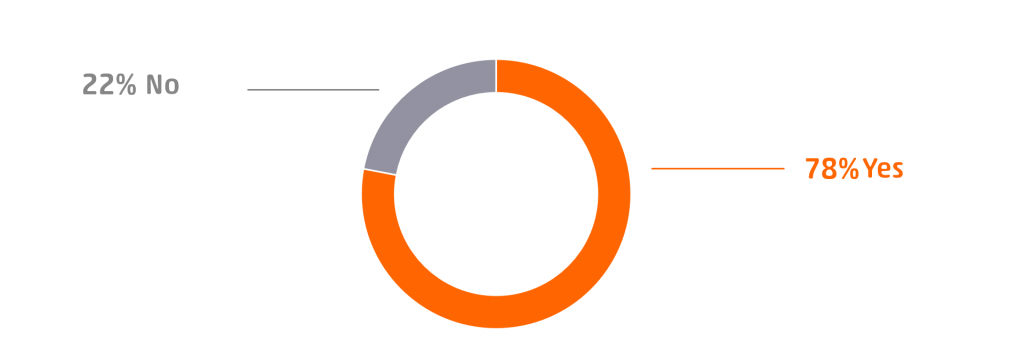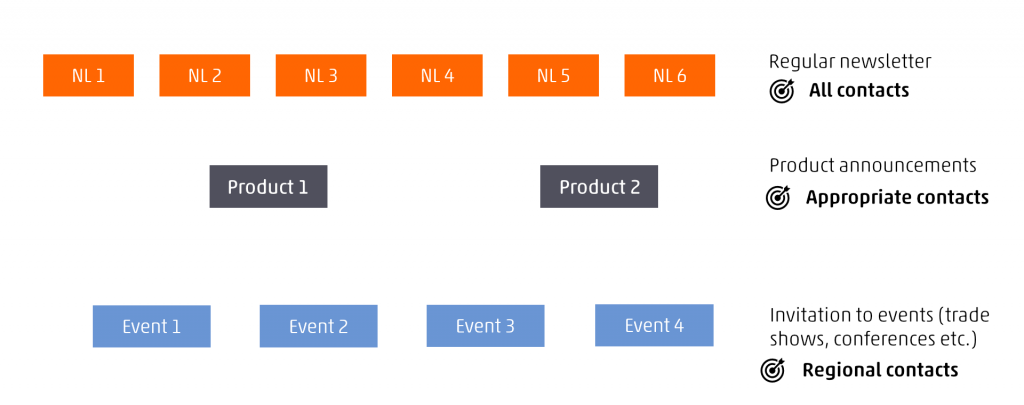
E-mail marketing is on everyone’s lips at the moment. But from what I see, many B2B companies are still not aware of the opportunities left untapped in e-mail marketing – even though e-mail marketing is the most successful online marketing tool of all. With this blog article, I hope to enthuse you for e-mail marketing and show you how the right e-mail marketing strategy can make you more successful.
Didn’t e-mail marketing die long ago?
Time and again you hear claims that e-mail marketing has long died and is a marketing tool of days gone by, supposedly because young people only use social media and not e-mails, and most certainly not marketing e-mails. I sometimes wonder where such statements come from. For 20 years I have been in B2B e-mail marketing and have seen the performance figures, such as opening rates and click rates, of thousands of different newsletters and e-mails. Over the years, I haven’t observed that the response to e-mails has ebbed off or that fewer recipients are responding to marketing e-mails. On the contrary, well-created e-mails in B2B are more successful and effective than anything else. This is not just my personal observation and opinion but is what various studies show. 59% of B2B marketing managers report that e-mail marketing is their most effective marketing channel. The click-through rates of B2B e-mails are 47% higher than in B2C (business to consumer), which clearly shows that B2B e-mails are perceived as useful by their recipients. Companies investing into e-mail marketing report a return on investment (ROI) of 39 euros for every euro spent. In B2B, e-mails are the third most important source for getting informed prior to purchase, only just behind the recommendations of colleagues and industry experts.

22 percent of B2B companies in the chemical, life sciences, analytical and laboratory technology and food & beverage industries do not yet use e-mail marketing. Source: Benchmark report e-mail marketing, LUMITOS AG
When you consider all the opportunities of e-mail marketing, it’s amazing that 22% of B2B companies in the chemical, life science, analytics, lab, food and beverage industries are still not using e-mail marketing. This is the result of a survey carried out by LUMITOS among 134 marketing managers. Of the companies that do use e-mail marketing, 21% disseminate less than five e-mails per year. What a shame about the untapped potential!
1. E-mail marketing makes it easier for you to address your contacts individually
Customisation is one of the great strengths of e-mail marketing. With a minimum of effort, it is possible to target thousands of contacts directly through a single e-mail shot, allowing you to get across the content and topics that are relevant and interesting to them. Most CRM systems offer far more customisation features than people think. I have selected some for you:
- Including the recipient’s name and address makes the e-mail look and feel less anonymous.
- Language and geography are important so you can address your contacts in their native language, letting your messages be understood the way you want them to.
- If you know that a subgroup of contacts is interested in certain products, your e-mail can focus on content that matters to them.
- Knowledge of the applications and the technologies used by your contacts puts you in a position to send them valuable application know-how, helping them to solve their day-to-day work challenges.
- Responses to earlier e-mails help you to better customise your subsequent communication to what interests your contacts.
- Adding the name and contact details of a recipient’s sales manager gives your e-mail a personal touch. This serves as a reminder of who the contact person within your company is.
Customisation of e-mails is also the most important success factor in e-mail marketing. The better your e-mails match the interests of your recipients, the more clicks they will generate. No other marketing tool makes it easier and more cost-effective to address thousands of recipients in person, all at the same time.
2. E-mail marketing increases the “visiting frequency” of your customers
How often do your salespeople actually go out to see your customers? Probably not as often as you would like. Looking at it realistically, it is hardly possible to pay all customers regular visits. But e-mail marketing can play an important role here. Your e-mails can help to inform all your customers regularly about the news you want to get across. It ensures that they all receive the information, regardless of how committed your sales staff are. Regular e-mails benefit your sales managers significantly, allowing them to rest assured that all customers have been informed. This lets your sales managers focus on the customers with the greatest potential.
3. E-mail marketing can be used for communicating (almost) anything
Another major strength of e-mail marketing is its widespread use for almost anything you wish to get across. Below I have put together the most important uses.
Addressing existing and potential customers
- Announcements of new products
- Information about (new) applications
- Providing user know-how, suggestions for product operation, maintenance and care
- Information about sales promotions
- Invitations to events (trade fairs, conferences, seminars, webinars)
- Information about suitable accessories and service contracts
- Reminder of due maintenance events
- Information material after visits to your trade fair booth
Addressing sales partners
- Announcements of new products
- Information about sales promotions
- Invitations to trade fairs
- Information about advertising material, competitive advantages, marketing campaigns etc.
Addressing specialised media & the press
- Sending press releases
- Invitation to press events
- Invitation to trade fairs
4. E-mail marketing keeps your address base updated
A welcome and invaluable side effect of e-mail marketing is that your customer address base remains up-to-date. All professional e-mail marketing tools include a bounce management that processes all returned e-mails and sorts them into different categories. This allows you to see at a glance which of your recipient addresses haven’t worked as they should:
- You find out which of your contact addresses no longer exist (hard bounces)
- You find out when the e-mail addresses of several recipients in the same company no longer function, e.g. when company names have changed (hard bounces)
- You become aware of temporary absences, e.g. parental leave (out-of-office messages)
- You can take note of referrals to new contact persons or representatives (soft bounces)
E-mail marketing can thus make an important contribution to improving your address quality in sales and marketing. Especially when disseminating e-mails regularly, you will recognise changes of staff and of responsibilities faster than your sales managers do. Where this concerns key customers, this information is worth pure gold.
5. E-mail marketing can indicate how well your marketing messages will work
Fast user responses, which typify e-mail marketing, provide you with a clear picture about the success or failure of your marketing measure in less than a day. E-mails are a great marketing tool to test the impact of your activities quickly and measurably before you transfer them to other marketing channels.
- The opening rate lets you see immediately how your core message is accepted in the market
- A/B tests that use the opening rate allow you to compare different messages
- The click rates for specific content or elements within the e-mail serve as an indication of how the market reacts
- A high unsubscribe rate is usually a clear indication that your content is not appreciated by your target group
Try to be brave, experiment and play around with the content of your e-mails. Nowhere can you learn so much so fast as in e-mail marketing.
My recommendation for establishing e-mail marketing
Based on my experience in B2B e-mail marketing, I recommend the following proven approach to achieve measurable success with your e-mails.

Example of an email marketing planning
The basis should be a regular newsletter that is delivered at least 6 times a year. Send one out every two months to stay in the minds of your target groups. Disseminate them to all recipients of your distribution list and make sure they contain a good mix of product information, applications and tips & tricks.
In addition to this basic information, you should send out e-mails about new products or product highlights at least twice a year, depending on the merit of the cause. Here, I recommend narrowing down the list of recipients to include only those for whom the advertised product is of interest and therefore relevant. Use the corresponding features in your CRM.
Many B2B companies regularly exhibit at trade fairs and conferences or offer their own seminars and webinars. E-mail marketing is a powerful tool to boost the attendance of events. If your event is regional, make sure to invite only those who live or work within about 100 kilometres from the venue. All others would just be bored by your announcement.
With this fairly simple set-up for disseminating e-mails, you’re likely to see significant success. Based on this, you can expand your e-mail marketing activities. For example, you could increase the frequency of your regular newsletters or of your product-related e-mails.

